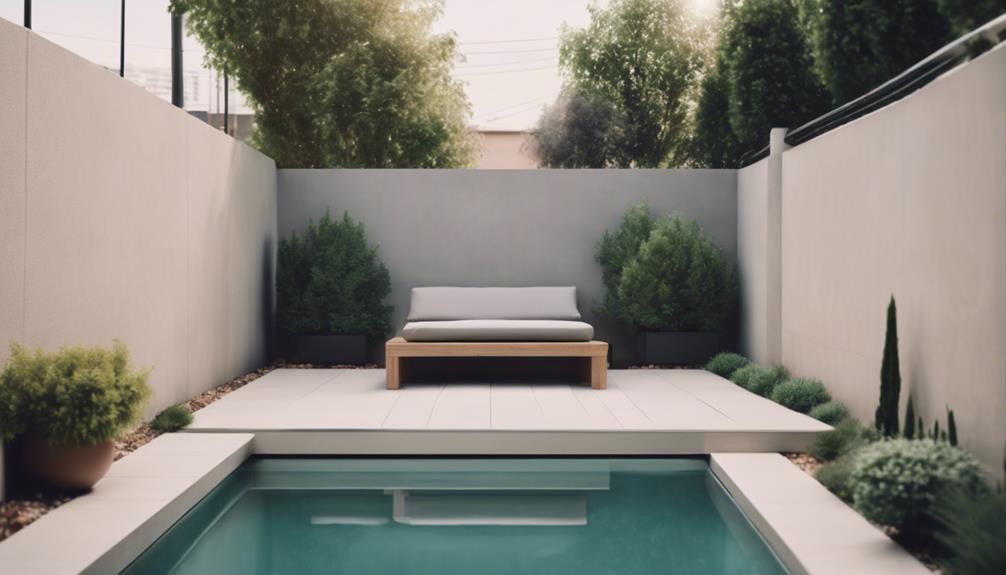Discover environmentally friendly natural pool design concepts for a chemical-free, wildlife-friendly sanctuary. Choose biologically filtered pools with essential liners, waterfalls, and sustainable stone edging. Improve water clarity with submergent hornwort and decrease algae growth with floating water hyacinth. Incorporate recycled glass tiles, bamboo decking, and non-toxic paints for a more sustainable pool environment. Ensure water quality by monitoring pH levels and maintaining plant balance. Cultivate a balanced ecosystem with diverse plant species such as water lilies. Immerse yourself in an eco-conscious swimming experience that blends aesthetics and sustainability for a rejuvenating pool getaway.
Key Takeaways
- Incorporate plant-based filtration systems for chemical-free water purification.
- Use sustainable materials like natural stones and recycled glass tiles.
- Opt for bamboo decking and non-toxic paints for eco-friendly pool construction.
- Balance aquatic plant varieties to enhance water clarity and biodiversity.
- Regularly monitor water quality and adjust levels for a thriving ecosystem.
Benefits of Natural Swimming Pools
Experience the rejuvenating benefits of natural swimming pools, where chemical-free water promotes healthier skin and eyes.
Natural swimming pools not only offer a revitalizing and eco-friendly swimming experience but also attract wildlife, supporting biodiversity. These pools are designed to be sustainable, cost-effective alternatives to traditional chemically treated pools.
By utilizing energy-efficient filtration systems, natural pools reduce their environmental impact while providing a clean and natural swimming environment. The absence of harmful chemicals not only benefits your health but also contributes to the overall reduction of chemical pollution in waterways, making natural swimming pools a responsible choice for the environment.
Embrace the beauty of a natural swimming pool that harmoniously blends with nature, creating a sustainable oasis for relaxation and enjoyment. Immerse yourself in the world of chemical-free swimming and discover the many advantages that natural pools have to offer.
Design Elements for Natural Pools

Explore the engaging design elements that make natural pools a distinctive and eco-friendly swimming option. Natural swimming ponds combine the beauty of decorative ponds with the functionality of swimming areas, using biological filters and plant life for a vital and self-sustaining water purification system.
These designs often incorporate features like separate filter ponds, waterfalls, streams, pergolas, decks, and equal or larger plant zones compared to the swimming areas, creating a harmonious blend of aesthetics and functionality.
Pond liners are essential to maintain the integrity of the pool structure, while water lilies and other aquatic plants not only enhance the visual appeal but also play an important role in maintaining water clarity and ecosystem balance.
Plant Selection for Water Purification

Selecting the right plants is essential for effectively purifying water in natural swimming pools. When it comes to plant selection for water purification, consider incorporating a variety of natural species to create a balanced ecosystem.
Submergent plants like hornwort and waterweed play a vital role in oxygenation and nutrient uptake, promoting water clarity.
Floating plants such as water hyacinth and duckweed not only provide shade to reduce algae growth but also offer a habitat for beneficial organisms.
Emergent species like pickerelweed and cattails aid in water filtration by absorbing excess nutrients and providing a surface area for beneficial bacteria to thrive.
Additionally, marginal plants like water iris and sweet flag contribute to stabilizing the pool's edge, filtering pollutants, and creating a connection zone between water and land.
Eco-Friendly Pool Construction Materials

Consider utilizing eco-friendly pool construction materials such as natural stones, recycled glass tiles, bamboo decking, non-toxic paints, and sustainable wood species to enhance the sustainability of your pool design. These materials not only contribute to a visually appealing pool but also help reduce the environmental footprint of your swimming area.
- Natural stones: Granite or limestone can be used for pool edges and surrounding areas, providing a durable and aesthetically pleasing finish.
- Recycled glass tiles: Sustainable choice for pool finishes, adding elegance and uniqueness to the pool design.
- Bamboo decking: Renewable and durable option for pool decks, offering a natural look and feel while being eco-friendly.
- Non-toxic paints: VOC-free coatings for pool surfaces, minimizing environmental impact and ensuring water safety.
- Sustainable wood species: Utilize teak or cedar for pool furniture and structures, enhancing the overall eco-friendly construction of your pool.
Maintenance Tips for Natural Pools

To keep your natural pool in top shape, make sure to regularly test the water quality and remove any organic debris that may affect its clarity.
Maintaining a balance of aquatic plants is essential for proper filtration, so don't forget to prune and care for them accordingly.
Remember to adjust water levels as needed to guarantee the best conditions for the plants and aquatic life in your pool.
Water Quality Testing
Regularly testing the water quality of your natural swimming pool is crucial for maintaining a healthy and sustainable aquatic environment. To guarantee the best conditions for swimming in your natural pool, follow these key steps:
- Test the pH levels to keep the water within the recommended range for safe swimming.
- Check chlorine levels, if used, to secure effective disinfection without overuse.
- Monitor water clarity to ensure a clean and inviting swimming environment.
- Keep an eye on alkalinity, calcium hardness, and dissolved oxygen levels to prevent any imbalances that could harm aquatic life.
- Utilize water quality test kits or electronic monitoring systems for accurate and convenient testing methods.
Organic Debris Removal
Removing organic debris from your natural pool is essential for maintaining water clarity and preserving the ecosystem balance. Organic debris like leaves, twigs, and insects can accumulate in natural pools, impacting water quality and potentially clogging the filtration system.
To effectively tackle this issue, regularly skimming the surface of the pool with a net or skimmer is recommended. This helps to remove floating debris before it sinks to the bottom.
For debris that has settled at the pool's bottom, using a pond vacuum or bottom drain can be highly beneficial in keeping your natural pool clean and clear.
Incorporating Wildlife in Pool Design

When designing a natural swimming pool, consider incorporating wildlife by creating habitats for turtles, frogs, and various aquatic species. Here are some tips to help you integrate wildlife into your pool design:
- Plant zones in natural pools attract beneficial insects, creating a balanced ecosystem that supports wildlife.
- Design features such as beach areas and shallow zones cater to the needs of wildlife within the pool environment.
- Integrating rocks and natural materials in pool design enhances habitat diversity and provides shelter for wildlife.
- Wildlife like dragonflies, snails, and amphibians contribute to the ecosystem balance in natural swimming pools.
- Incorporating built-in biological filters can help maintain water quality while supporting a thriving wildlife population.
Frequently Asked Questions
What Is the Cheapest Way to Build a Natural Swimming Pool?
The cheapest way to build a natural swimming pool is by converting an existing pool, opting for a DIY construction with a conversion kit, choosing a smaller design, using locally-sourced materials, and collaborating with a natural pool designer for a simplified layout.
What Is the Most Environmentally Friendly Pool?
When it comes to the most environmentally friendly pool, natural swimming pools take the lead. By using plants and biological filters instead of chemicals, these pools promote a healthier ecosystem and lower environmental impact.
How to Build an Eco-Friendly Swimming Pool?
To build an eco-friendly swimming pool, start with natural filtration using aquatic plants and beneficial bacteria. Use energy-efficient pumps and eco-materials like natural rocks. Blend the pool with the landscape and harvest rainwater for filling, reducing environmental impact.
How to Make a Swimming Pool Look Natural?
To make a swimming pool look natural, incorporate rocks, plants, and organic shapes. Use wood decking, stone paving, and gravel for a seamless blend with the environment. Add water features like waterfalls for a soothing touch. Choose earthy colors to complement the natural aesthetic.
How Can I Incorporate Eco-Friendly Design Into My Natural Swimming Pool?
When considering swimming pool garden ideas, incorporating eco-friendly design into your natural swimming pool can be achieved by using sustainable materials for the pool construction, planting native vegetation around the pool area, and implementing a natural filtration system to reduce chemical usage. Creating a harmonious, eco-friendly oasis is possible with careful planning and design.
How Can I Incorporate Eco-Friendly Designs into my Swimming Pool with a Stylish and Secure Fence?
Incorporate eco-friendly designs into your swimming pool with stylish swimming pool fence ideas. Choose sustainable materials like bamboo or recycled wood for your fence. Opt for solar-powered lighting or energy-efficient pool pumps to reduce your environmental impact. Look for stylish designs that also provide security and meet safety standards.
Conclusion
To sum up, natural swimming pools offer a sustainable and eco-friendly alternative to traditional pools. By incorporating elements such as plant filtration and wildlife habitats, you can create a serene oasis that benefits both you and the environment.
So, why not immerse yourself in the world of natural pool design and make a splash with a pool that's as beautiful as it's environmentally conscious?










